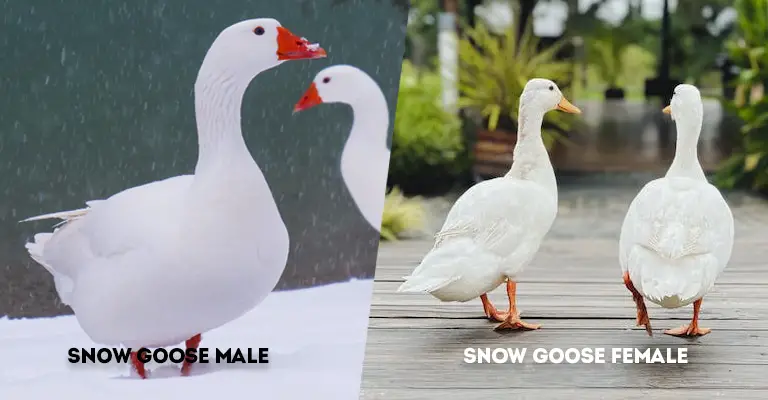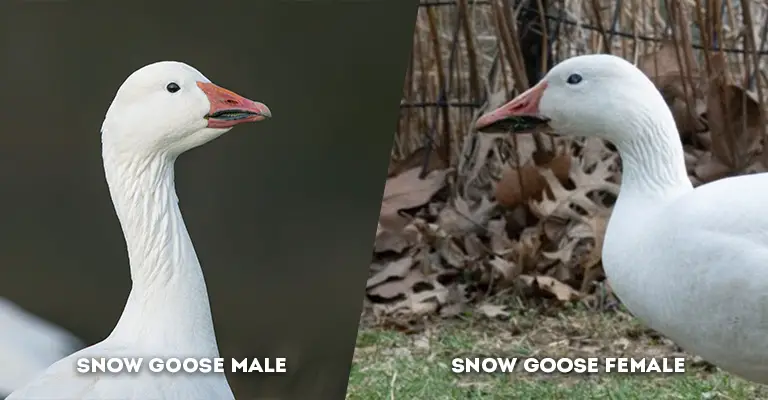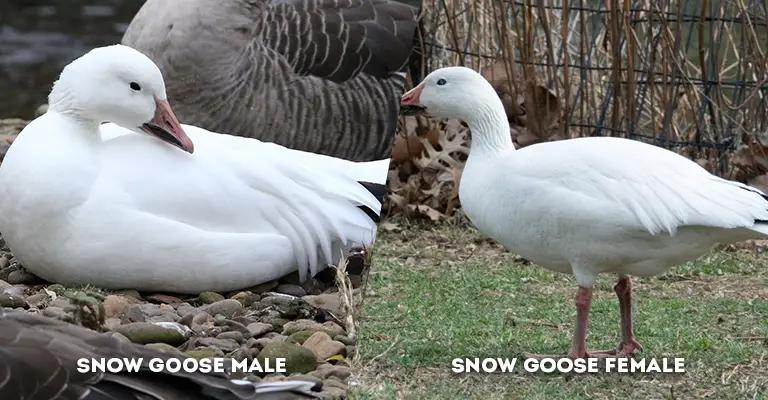Snow geese are elegant and migratory waterfowl known for their distinctive behaviors and striking plumage variations.
While the sexes of snow geese share many similarities in appearance, including the two color phases dark (blue) and white (snow) there are subtle differentiating characteristics that set them apart.
This article delves into these nuanced distinctions, exploring a range of traits including body size, behavior, vocalizations, and more.
By examining these differences, we gain a deeper understanding of how male and female snow geese adapt to their roles within the species and contribute to the intricacies of their ecology and migration patterns.

Key Differences Between Snow Goose Male and Female
Snow geese are sexually dimorphic, which means that there are visible differences between males and females.
Here are some key differences between male and female snow geese:
Size
- Male Snow Goose: Male snow geese are typically slightly larger in size compared to their female counterparts.
This difference might be observed in terms of body length, wingspan, and overall bulk. While not a drastic contrast, males tend to exhibit a slightly more elongated body and a somewhat larger wingspan. - Female Snow Goose: Female snow geese, on the other hand, are generally slightly smaller in size. This distinction is noticeable in their overall body proportions, with females having a more compact body structure and a slightly shorter wingspan compared to males.
Plumage Color
- Male Snow Goose: The plumage color of male snow geese does not serve as a reliable indicator of their sex. Male snow geese can exhibit either of the two color phases seen in the species: the dark (blue) plumage or the white (snow) plumage.
The color phase of a male snow goose is not linked to its sex; males can be found in both blue and white variations. - Female Snow Goose: Similar to males, female snow geese can also display both the dark (blue) and white (snow) plumage variations. The color phase a female exhibits does not provide insight into her sex; females can be observed in both blue and white forms.
Bill Size
- Male Snow Goose: Male snow geese often exhibit slightly larger bills compared to their female counterparts.
While the difference in bill size can be subtle, it is more noticeable when observing multiple individuals together. The male’s bill may appear somewhat more robust and elongated than that of the female. - Female Snow Goose: Female snow geese generally possess slightly smaller bills. This characteristic contributes to their overall more petite facial appearance.
While not a definitive distinguishing factor on its own, the difference in bill size between males and females can aid in identification.
Head Shape

- Male Snow Goose: Male snow geese tend to have a rounded head shape. Their cranial structure appears slightly fuller, which can give them a more substantial and robust look when compared to females.
- Female Snow Goose: Female snow geese often display a head shape that is slightly more tapered and streamlined.
This is especially noticeable when comparing them side by side with males. Their head shape contributes to their overall sleeker and slightly more delicate appearance.
Neck Length
- Male Snow Goose: The neck of the male snow goose is usually slightly longer than that of the female.
This elongation is a subtle but consistent feature that becomes apparent upon closer observation. The longer neck contributes to the male’s more elongated and somewhat regal appearance. - Female Snow Goose: Female snow geese typically possess a slightly shorter neck. While the difference might not be immediately obvious, it does contribute to the overall proportions of the female’s body and contributes to her more compact appearance.
Body Shape

- Male Snow Goose: Male snow geese generally exhibit a more elongated body shape compared to their female counterparts.
This elongation is most noticeable when observing them side by side. Males tend to have a slightly larger overall frame, which contributes to their more substantial appearance. - Female Snow Goose: Female snow geese have a slightly more compact body shape. This characteristic gives them a subtly different silhouette when compared to males. The shorter body proportions contribute to the overall daintier appearance of the females.
Aggression
- Male Snow Goose: During certain periods, particularly the breeding season, male snow geese can display higher levels of territorial behavior and aggression.
This aggression is often directed towards other males, especially when competing for nesting sites or defending their territory. - Female Snow Goose: Female snow geese are generally less aggressive compared to males, especially during the breeding season.
While they might still engage in some territorial behaviors, their aggression is typically not as pronounced. Instead, females focus more on nesting and caring for their young.
Behavior During Breeding
- Male Snow Goose: Male snow geese play a more assertive role during the breeding season. They actively compete for prime nesting sites and engage in courtship displays to attract females.
Males might be observed performing various displays, such as head bobbing and calling, to establish dominance and attract mates. - Female Snow Goose: Female snow geese take on the primary responsibility of nesting and incubating eggs. Their behavior during the breeding season is focused on finding suitable nesting sites, constructing nests, and incubating eggs.
While they might still engage in social interactions, their behaviors are more centered around ensuring the successful development of their offspring.
Vocalizations
- Male Snow Goose: Male snow geese are known for their distinctive and often louder vocalizations, especially during the courtship phase.
Their calls can be more intense and resonating, often used to communicate with females and establish dominance over other males. - Female Snow Goose: Female snow geese also vocalize, but their calls are generally softer and less elaborate compared to males. They might use these calls to communicate with their mates, signal distress, or maintain contact within the flock.
Feeding Habits
- Male Snow Goose: Male snow geese, like females, are actively involved in feeding to maintain their condition and energy levels.
They often forage in groups, particularly during migration, and might exhibit a slightly more competitive behavior when feeding. - Female Snow Goose: Female snow geese also engage in feeding to sustain themselves, especially during the demanding breeding and nesting periods.
However, their feeding habits might be more moderate compared to males, as they need to conserve energy for incubation and caring for their young.
Nesting Role
- Male Snow Goose: The nesting role of male snow geese is relatively limited. While males might assist in selecting a nesting site and occasionally contribute some nesting material, their involvement in nest-building is generally minimal.
- Female Snow Goose: Female snow geese take on the primary nesting role. They invest significant effort in constructing the nest, arranging materials, and creating a suitable environment for incubating the eggs.
Parental Care
- Male Snow Goose: Male snow geese are less involved in direct parental care after the eggs hatch. They might maintain a general protective presence around the nest, but their primary role shifts toward guarding the nesting territory.
- Female Snow Goose: Female snow geese are extensively involved in parental care. After the eggs hatch, they take on the responsibility of feeding, protecting, and nurturing the young goslings. Females lead their young to suitable foraging areas and provide guidance during migration.
Social Behavior
- Male Snow Goose: Male snow geese tend to display more social behavior during the non-breeding season. They often gather in larger groups, forming flocks with other males, where they engage in activities like foraging and resting.
- Female Snow Goose: Female snow geese exhibit a more focused social behavior, especially during the breeding season. They form smaller family groups that include their mate and offspring. These groups prioritize nesting and rearing activities.
Migration Behavior
- Male Snow Goose: Male snow geese often initiate migration slightly earlier than females. This behavior might be linked to their territorial tendencies, as they move ahead to secure prime breeding and feeding areas.
- Female Snow Goose: Female snow geese tend to migrate slightly later, likely because they need to ensure that their young are strong enough to undertake the demanding journey.
This delayed migration allows them to provide sufficient care to their offspring before embarking on the migration route.
Bill Coloration
- Male Snow Goose: The bill coloration of male snow geese is consistent with that of females. Both sexes have bills with a pinkish hue, which can range from pale pink to reddish. Bill coloration does not serve as a reliable indicator of sex.
- Female Snow Goose: Like males, female snow geese also have bills with a pinkish hue that can vary in intensity. This characteristic is shared between the sexes and is not useful for distinguishing between males and females.
Leg Coloration
- Male Snow Goose: The leg coloration of male snow geese is relatively consistent between the sexes. Both males and females typically have legs with a pink or reddish hue. This characteristic does not serve as a reliable indicator of sex differentiation.
- Female Snow Goose: Like males, female snow geese also possess legs with a pink or reddish hue. The leg coloration is a shared feature and does not provide a means of distinguishing between males and females.
Eye Color
- Male Snow Goose: The eye color of male snow geese is relatively uniform across both sexes. Male and female snow geese typically have dark brown to black eyes. Eye color does not vary based on sex.
- Female Snow Goose: Female snow geese, similar to males, have dark brown to black eyes. This consistent eye coloration is not a distinguishing feature between the sexes.
Bill Shape
- Male Snow Goose: The shape of the bill can exhibit subtle differences between the sexes, but these differences are not always consistent. In some cases, male snow geese might have slightly thicker bills compared to females.
- Female Snow Goose: Female snow geese generally have bills that are slightly more slender compared to males. However, this difference is not always readily noticeable and might not be a reliable characteristic for sex identification.
Feather Quality
- Male Snow Goose: Male snow geese might exhibit slightly more vibrant feather quality compared to females. This could be due to the influence of hormones on feather pigmentation, resulting in slightly brighter colors in some individuals.
- Female Snow Goose: Female snow geese might have feathers that appear slightly duller in comparison to males. This difference in feather vibrancy is subtle and might not be consistently observed across all individuals.
Wingbeat Pattern
- Male Snow Goose: Male snow geese often exhibit a slightly stronger wingbeat pattern when in flight. This difference might be attributed to their generally larger size and more elongated body shape.
- Female Snow Goose: Female snow geese typically have a slightly lighter wingbeat pattern compared to males. Their more compact body shape contributes to this characteristic, allowing for a slightly different flight style.
Migratory Distances
- Male Snow Goose: Male snow geese tend to cover longer migratory distances compared to females. This behavior is linked to their slightly earlier migration initiation and might be connected to their role in establishing nesting territories ahead of the breeding season.
- Female Snow Goose: Female snow geese usually cover shorter migratory distances compared to males. Their migration is slightly delayed due to their focus on caring for and ensuring the strength of their offspring before undertaking the demanding journey.
Snow Goose Male Vs Female: Comparison Table
| Feature | Snow Goose Male | Snow Goose Female |
|---|---|---|
| Size | Slightly larger | Slightly smaller |
| Plumage Color | Blue or white, same as female | Blue or white, same as male |
| Bill Size | Feeds actively to maintain the condition | Generally slightly smaller bill |
| Head Shape | Rounded head | Slightly more tapered head |
| Neck Length | Slightly longer neck | Slightly shorter neck |
| Body Shape | More elongated body | Slightly more compact body |
| Aggression | More territorial and aggressive | Less territorial and aggressive |
| Behavior During Breeding | Defends nesting sites, displays | Focuses on incubation and care |
| Vocalizations | Distinctive calls during courtship | Softer calls during incubation |
| Feeding Habits | Less involved in chick-rearing | May feed more moderately |
| Nesting Role | Less involved in nest-building | Primarily responsible for nesting |
| Parental Care | Less involved in chick rearing | Major role in protecting and feeding |
| Social Behavior | Associates with other males in groups | Often forms smaller family groups |
| Migration Behavior | May initiate migration earlier | May migrate slightly later |
| Bill Coloration | Pinkish hue | Pinkish hue |
| Leg Coloration | Pink or reddish | Pink or reddish |
| Eye Color | Dark brown to black | Dark brown to black |
| Bill Shape | Can be slightly thicker | Can be slightly more slender |
| Feather Quality | Feathers might appear more vibrant | Feathers might appear slightly duller |
| Wingbeat Pattern | Slightly stronger wingbeats | Slightly lighter wingbeats |
| Migratory Distances | May cover longer migratory routes | May cover shorter migratory routes |
Frequently Asked Questions
Yes, male and female snow geese have slightly different vocalizations. Males often produce louder and more distinctive calls, especially during courtship and territorial displays. Female calls are generally softer and used for communication within the flock.
No, there are no discernible differences in bill coloration between male and female snow geese. Both sexes typically have bills with a pinkish hue that can vary in intensity but are not indicative of their sex.
Male snow geese tend to form larger social groups with other males during the non-breeding season. They often forage and rest together in these groups. In contrast, female snow geese form smaller family groups that prioritize cooperative activities and caregiving.
The differences in feather quality between male and female snow geese are generally subtle and might not be readily noticeable in all individuals. While males might exhibit slightly more vibrant feathers, this characteristic might not be consistent across the entire population.
Male snow geese often initiate migration slightly earlier than females. This behavior allows them to secure prime nesting and feeding areas ahead of time. Female snow geese migrate slightly later, ensuring their young are strong enough for the journey before embarking on migration. This staggered migration pattern benefits the survival of the species.
To Recap
In the realm of snow geese, the intricate tapestry of differences between males and females goes beyond mere physical attributes.
From behaviors during breeding and parenting roles to vocalizations and migratory strategies, each sex plays a unique part in the survival and perpetuation of the species.
Despite the subtlety of these distinctions, they underscore the remarkable ways in which nature has shaped these waterfowl for diverse and complementary roles.
By appreciating these variations, we not only deepen our understanding of snow geese but also gain insights into the delicate balance that defines the world of avian biology and ecology.